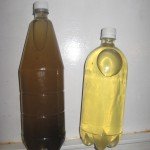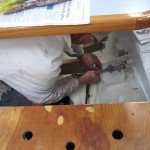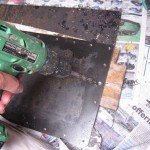How to amuse yourself on a rainy day.
Or how I got over contaminated diesel
It is raining in the Gulf, as we are at anchor in a bay on the southern side of Waiheke Island. The Admiral is thinking of making a meatless roast, something I have not had since my birthday just prior to sailing off into rough water around the top of the North Isld some year in the 90’s. It was not surprising that I saw my dinner twice that night. She can make meatless roasts and I can simply decide what calamity to fix. Gosh darn it, what else would I be doing in the Gulf on a crappy day? Our latest calamity is having dirty fuel tanks.
We have had some issues with diesel ever since our motor conked out just as we were motorsailing into a stiff northerly outside Wellington. Stiff was not the word for it. More like a bloody full on gale. We were on a starboard tack when the motor ground to a halt. Rather than sail into Island Bay through a narrow rock strewn channel, I chose to have the Admiral tack back and forth in the moderate sea, while I changed tanks and bled air out of the fuel pipes. Looking back, it is now apparent that the tank outlet became blocked when sludge in the bottom of the tank was shifted to the outlet end.
The recent ‘incident off Narrow Neck Beach’ when our motor conked out just as we dropped anchor while fishing with Bro-In-Law was totally unrelated to today’s crisis. That was a cognitive problem, when we ran out of fuel. The Admiral argued that it was a cognitive problem specific to me. Read tanks ran dry.
Recently had I tapped a diesel sample from the drain plug at the bottom of the tank. Luckily for us, the builder Andrew Wooton made a drain in the right place. The sample was not a pretty sight. It was a clumped black mass that filled the bottom of the sample bottle. Yes, you immediately think diesel bug, the dreaded bacterial infection that grows on a mixture of water and diesel. The tanks had no inspection plates that we could take off to clean the tank. One tank was full, the other half full. What do I do?
Immediate action to solve possible diesel bug.
Firstly, a panic stricken email to our friend Nigel in the UK who had suffered the bug several years ago. He gave me some good ideas.
I dropped crushed mothball into the tank. Mothball as a biocide is unknown, but a diesel mechanic told me that the naphthalene was an effective biocide against diesel bug. Not one to spend huge amounts of money on proprietary remedies, I had been treating the tanks regularly this way for years. As back up, I would purchase some commercial fuel treatment. (Below.)
I took samples from each tank and mixed them with water in a jar before placing in a warm place. Any bacterial infection would grow in the mix. However, I had treated the water with ‘my’ biocide the day before, so results might be skewed. If any, it would at least show that the mothballs might be effective, and the sludge was a pile of dead organisms.
I got on the blower and ordered two Cor-ten steel plates 450mm X 270mm from a local engineer. I would drill and countersink holes in the plates, and later when I had the chance to empty the tanks, I would cut holes and tap screw holes for 3/16 stainless steel machine screws. Next day, the local engineer on Waiheke Island had finished two plates for $20 each. Super.
I also ordered by telephone from Smart Marine, some GrotaMar 71, a biocide manufactured in USA. It had a glowing report in a consumer report made by PBO, several years ago. As soon as this arrived at the post office, I dosed both tanks both with a cure dose, and in future will be added as prophylactic treatment. GotoMar 71 is a broad spectrum biocide that would attack various types of infection, and also condition the fuel, including remove residual water.
History of Wild Bird’s diesel tanks.
- Horror stories of the diesel bug abound in yachting circles, so I had always been careful to treat fuel with biocide and diesel conditioner. Each year I drained any bottom water droplets and sludge. I kept the tanks full to prevent water condensation in the integral steel tanks. Water is needed to provide nutrition for the ‘bugs’. Of course we all know that the bugs are microscopic, being algal, fungal or bacterial in nature.
- Going around the world, it had been difficult to source clean fuel all the time. Once while motoring across the equatorial doldrums through Indonesia, we purchased diesel fuel off fishermen in a village who scooped it from a 44gal drum into our containers. And so on.
- I have two pre filters and one primary filter on the engine plus two water traps.
- It would probably be a good idea to invest in the Kiwi diesel bug treatment that utilizes magnetic flux to kill off organisms that pass through before reaching the injector pump. It looks like an ordinary fuel filter.
- Not having an inspection hatch has always put me on the back foot. It is a suspected infection that has finally prompted me to install tank hatches.
The use of naphthalene compounds as found in mothballs is completely untested as far as I know. To date my two test pots of water and diesel have not grown sludge. Any comments please.
The jury is still out on whether or not the tanks are infected. Although the sludge and slime on the tank bottom is causing blockage to the fuel outlets, it might have been there for a long time either as accumulated sediment from contaminated fuel or it might be dead organisms and sludge, or it could be a clump of live organisms feeding on the water that accumulates at the bottom of the tank. Either way, it will be prudent to treat the diesel and then clean each tank as they become empty.
- Regular prophylactic chemical treatment, an installation of a ‘bug’ filter, water drain-offs and tank clean outs will keep the contamination at bay.
Hey, just to show it is not all head down, bum up. I had some dried tuatua (clams, bivalves, shell fish) salted and steeped in tuna oil in a jar stowed away. Put this on a hook and threw over while having breakfast. Left on ‘bait catcher’ mode, and bingo, zzzzzzz zzzz. What a surprise, in a shallow anchorage. High water, and just off an extensive tidal flat flush with shell fish and goodies for hungry snapper.
Reference. http://www.docstoc.com/docs/19858597/diesel-bug-fuel-treatments





Hi there Colin, I read with intrigue about a crushed mothball being used as a biocide, did it work? If not, you should try our DE-BUG units manufactured in NZ for over 20 years and used all over the world. http://www.dieselsolutions.co.nz
Guaranteed to significantly reduce live bug or your money back…hope those snapper tasted great!
Hi Jon many thanks for your comment. Indeed I used mothballs, containing napthalene (present, I understand, in most fuels to a small degree). The literature is scanty on the subject. During the time I used it, I never had problems with blocked filters. However that is not a scientific result. I need a jar of real bug, and to test it with a control. The muck I saw in the bottom of the tank did not seem to be bug.. it did not block filters, but did block the fuel outlet. I presume that it was simply 20 years accumulation of sediment. I mixed it with diesel and water, in a jar but did not grow cloudy in a week.
Your DeBug seems an impressive product, and the website certainly verifies its efficacy as a bug buster. I explore the different possibilities in an article I wrote for Cruising Helmsman, yet to be published. The drama of getting the bug is a big one for boaties, and my drama of putting in a fuel tank lid was a drama in itself, especially when doing the job myself.. In the meanwhile I use Grotamar as a chemical solution.
I expect the fishing to improve with the coming warmer waters and will no doubt keep readers informed. Cheers Colin